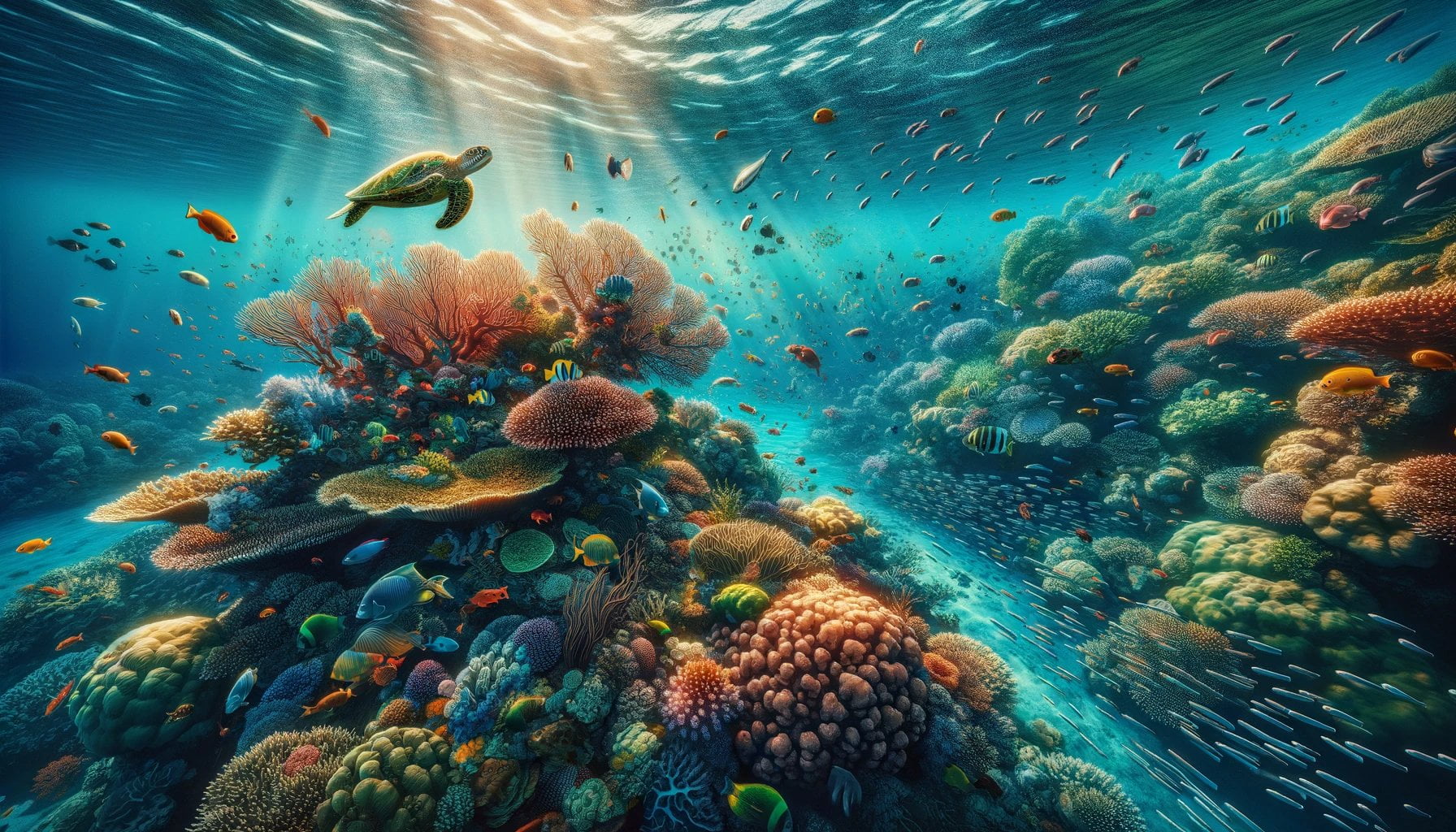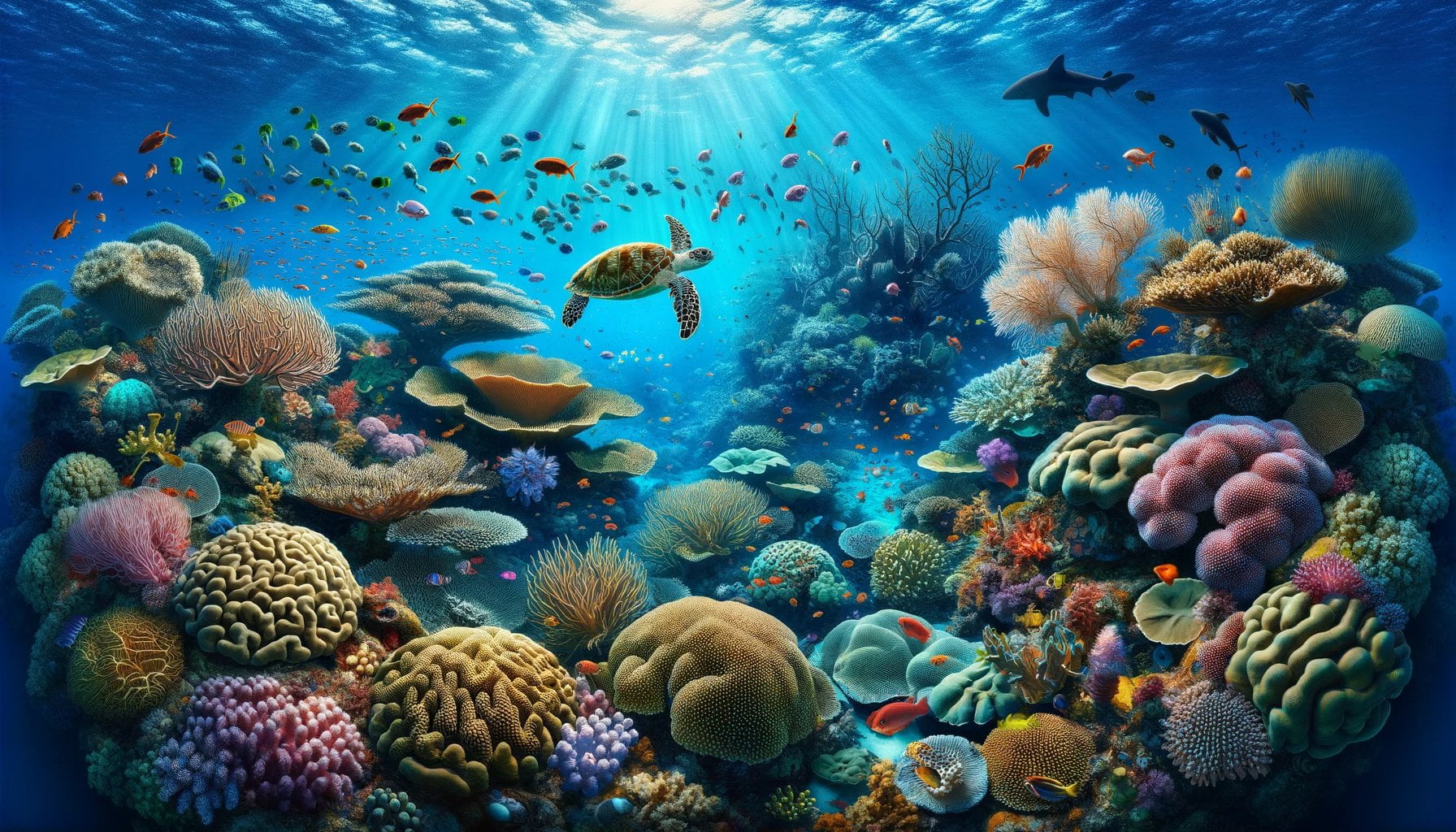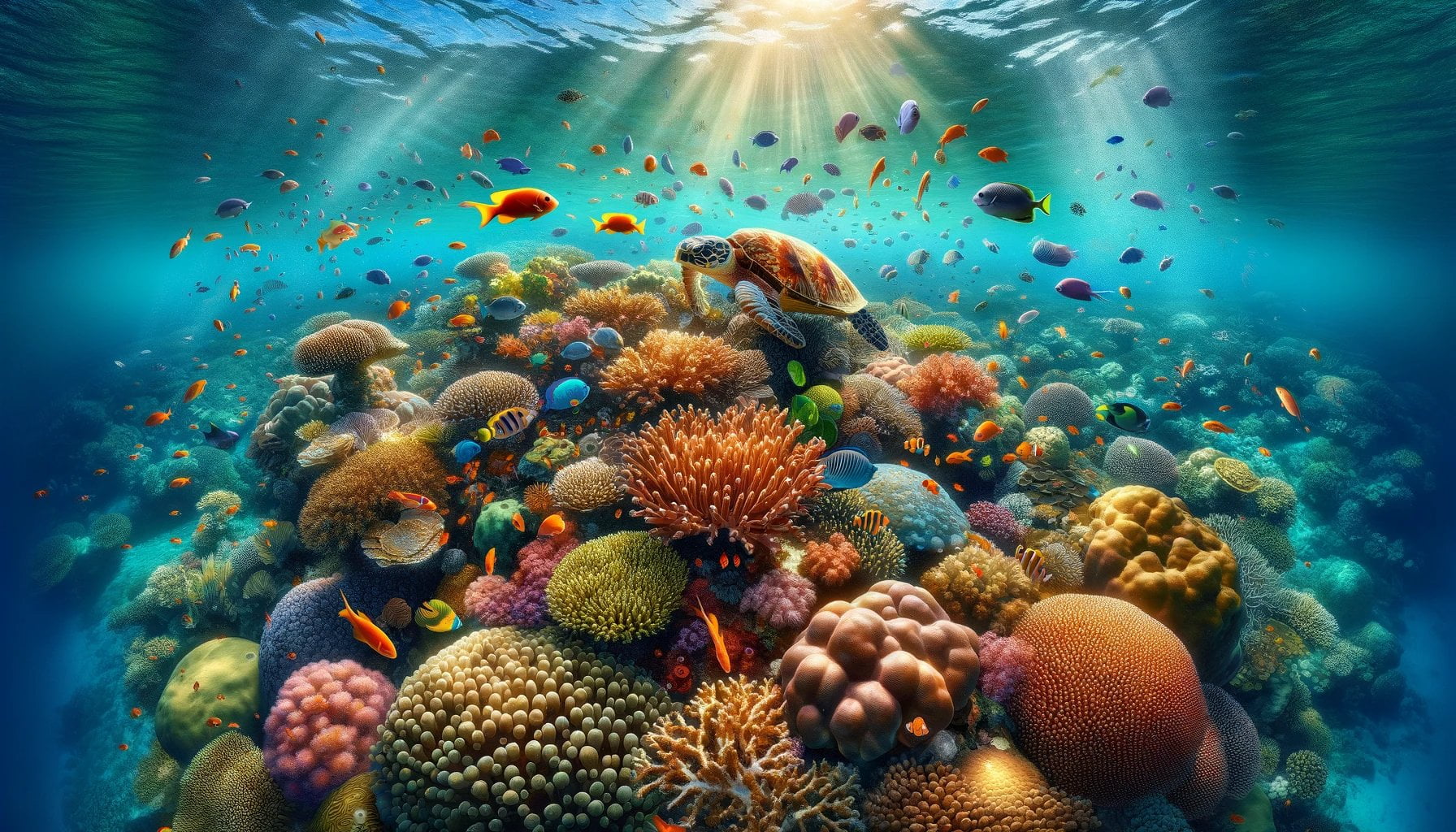Embark on a fascinating journey into the depths of the world’s largest coral reef system, the Great Barrier Reef. As a seasoned marine biologist and nature enthusiast, I invite you to immerse yourself in the wondrous realm of this magnificent underwater wonderland. In this article, we will delve into the top 10 facts about the Great Barrier Reef, shedding light on its extraordinary biodiversity, the threats it faces, and the vital importance of protecting this fragile ecosystem. Prepare to be amazed as we explore the wonders hidden beneath the turquoise waters of this unparalleled natural wonder.
Key Takeaways:
- The Great Barrier Reef is approximately 500,000 years old and is composed of several UNESCO World Heritage sites divided into 70 World Heritage bioregions and 30 reef bioregions.
- The reef is home to 900 islands and is a popular destination for divers due to its diverse marine life and underwater beauty.
- With around 5,000 marine species, the Great Barrier Reef is one of the most biodiverse places on Earth.
- The reef is known for its “Great Eight,” which consists of the most iconic animals found in the area.
- In addition to marine life, the Great Barrier Reef is also home to various land animals, including birds, reptiles, and mammals.
- Prehistoric animals such as crocodiles and turtles can be found in the reef ecosystem.
- The Great Barrier Reef is the largest living structure on Earth and is visible from space.
- However, the reef is under threat from climate change, coral bleaching, and human activities.
10 Facts About the Great Barrier Reef

The Great Barrier Reef is truly a natural wonder, teeming with life and beauty. As a marine biologist with a deep passion for conservation, I have spent years studying and researching this incredible ecosystem. Today, I want to share with you 10 fascinating facts about the Great Barrier Reef that will awe you and make you realize why it is so important to protect this delicate environment.
1. A Living Wonder
The Great Barrier Reef is an ancient marvel, with a history that spans approximately 500,000 years. It has weathered countless storms and witnessed the rise and fall of civilizations, making it a living testament to the power and resilience of nature.
2. A Diverse Heritage
This UNESCO World Heritage site is not just a single entity but a complex network of ecosystems. It is divided into 70 World Heritage bioregions and 30 reef bioregions, each with its own unique array of marine life. From the shallow lagoons to the deep-sea trenches, every region is a treasure trove waiting to be explored.
3. Island Paradise
The Great Barrier Reef is home to a staggering 900 islands that dot its turquoise waters. These islands offer a refuge for countless species, including birds, reptiles, and mammals. Walking along their pristine beaches and witnessing their untouched beauty is an experience like no other.
4. An Underwater Wonderland
Diving enthusiasts from around the world flock to the Great Barrier Reef for a reason. Its crystal-clear waters are home to a stunning diversity of marine life and breathtaking underwater landscapes. Every dive is an opportunity to encounter elusive sea creatures and witness the vibrant colors of the coral gardens.
5. The Biodiversity Hotspot
Prepare to be amazed by the sheer number of species that call the Great Barrier Reef home. Over 5,000 marine species have been identified within its boundaries, making it one of the most biodiverse places on Earth. From charismatic dolphins and majestic whales to tiny seahorses and dazzling clownfish, the reef is a bustling hub of life.
6. The Great Eight
Within this vast marine ecosystem, there are eight iconic animals that captivate the hearts of both divers and researchers. Known as the “Great Eight”, these include the awe-inspiring humpback whales, playful dolphins, graceful manta rays, enigmatic sharks, colorful clownfish, ancient green sea turtles, spiky sea urchins, and mysterious giant clams. Encountering any of these magnificent creatures is a true privilege.
7. A Land Beyond the Waters
While the focus may be on the marine environment, the Great Barrier Reef is also a haven for various land animals. From the call of seabirds soaring through the sky to the sight of sunbathing turtles and sun-loving reptiles, the reef’s islands and shores provide sanctuary for a variety of terrestrial and airborne species.
8. A Journey Through Time
Exploring the Great Barrier Reef is like stepping back millions of years into the past. Prehistoric creatures such as crocodiles and marine turtles, which have experienced little change over time, can still be found in the reef ecosystem today. In their presence, we are reminded of the interconnectedness of all life on Earth and the importance of biodiversity conservation.
9. A Living Wonder Visible from Space
One of the most incredible facts about the Great Barrier Reef is that it is the largest living structure on Earth. Stretching over 2,300 kilometers (1,430 miles) along the Northeastern coast of Australia, its vastness is even visible from space. Such a grand display of natural beauty reminds us of the need to safeguard this delicate ecosystem for future generations.
10. A Fragile Future
Sadly, the Great Barrier Reef faces numerous threats that jeopardize its future. Climate change, coral bleaching, and human activities such as pollution and overfishing are taking a toll on this precious ecosystem. Urgent action is needed to mitigate these threats and protect the reef’s fragile balance.
As a passionate advocate for marine conservation, I hope these 10 facts about the Great Barrier Reef inspire you to learn more, spread awareness, and join the collective efforts to safeguard this irreplaceable natural wonder. Let’s preserve the beauty and biodiversity of the Great Barrier Reef for generations to come. Together, we can make a difference.
Check out these 10 interesting facts about coral reefs! Explore the wonders of these underwater ecosystems and learn more about their importance to marine life. Dive into the fascinating world of coral reefs by clicking here.
Discover the remarkable Arctic fox and its incredible adaptations to survive in harsh Arctic environments. Uncover 10 fascinating facts about the Arctic fox by clicking here. Get ready to be amazed!
The Reef’s Incredible Biodiversity: Discover the Top 10 Great Barrier Reef Facts
The Great Barrier Reef is an awe-inspiring natural wonder, teeming with an astonishing array of marine life. Dive into the depths with me as I reveal the top 10 facts that showcase the reef’s remarkable biodiversity and the urgent need for its protection.
Breathtaking Diversity Underwater
The reef is home to a diverse range of marine species, including more than 1,500 species of fish and 600 types of hard and soft coral[^1^][^2^]. Imagine witnessing the vibrant colors and graceful movements of these underwater creatures. It’s like stepping into a hidden world of endless wonder.
A Magnificent Underwater City
Picture the reef as a bustling metropolis, populated by an array of species. Over 9,000 known species of marine life thrive within its waters, from whales and dolphins to six of the world’s seven species of marine turtle[^1^]. Every dive offers the chance to encounter mysterious creatures and marvel at their behavior.
Constant Discoveries
The Great Barrier Reef continues to reveal its secrets, with scientists regularly making new discoveries of species. It’s a testament to the reef’s immense biodiversity and the mysteries that still await exploration.
A Kaleidoscope of Coral
Immerse yourself in the breathtaking diversity of coral formations. With over 400 types of coral, the reef showcases an incredible variety of shapes, sizes, and colors. These delicate organisms give life and structure to the reef, creating intricate habitats for countless marine creatures.
Vastness Beyond Imagination
Stretching over an immense area of 348,700 square kilometers, the Great Barrier Reef is the world’s largest system of coral reefs[^1^]. Its vastness is so enormous that it can even be seen from space, a testament to its grandeur and ecological significance.
A Natural Heritage
Recognized as a UNESCO World Heritage site, the Great Barrier Reef has been celebrated for its remarkable variety and beauty. It is not only a treasure for Australia but for the entire world. Its preservation is of utmost importance, as its loss would have devastating consequences for global biodiversity.
A Fragile Balance in Peril
Unfortunately, the reef faces numerous threats that put its fragile balance at risk. Climate change, pollution, and coral bleaching are taking a toll on this ancient marvel. Urgent action is required to protect and restore the reef’s delicate ecosystem.
A New Branch in the Coral Family Tree
Recent scientific expeditions have led to an exciting discovery in the Great Barrier Reef—a new species of branching coral. This finding highlights the reef’s ongoing evolution and the potential for future discoveries that could contribute to scientific knowledge and conservation efforts.
Unveiling the Reef’s Hidden Depths
Thanks to advancements in technology, the Great Barrier Reef has been meticulously mapped in 3D. This mapping has revealed the reef’s diverse and unique topography, providing valuable insights into its complex ecosystem.
The Urgency of Conservation
We must come together to protect the Great Barrier Reef and its invaluable biodiversity. The reef’s incredible range of marine species, including its 1,500 species of fish and 600 types of hard and soft coral, are testament to its biological richness and vulnerability. Join the fight for conservation to ensure the reef remains a thriving ecosystem for generations to come.
Key Takeaways:
- The Great Barrier Reef boasts an awe-inspiring biodiversity, housing over 9,000 known species of marine life.
- Its waters are home to more than 1,500 species of fish and 600 types of hard and soft coral.
- The reef’s vastness spans an area of 348,700 square kilometers, making it the world’s largest system of coral reefs.
- Recognized as a UNESCO World Heritage site, the reef is a natural heritage of remarkable beauty and ecological significance.
- Threats such as climate change, pollution, and coral bleaching pose serious challenges to the future of the reef.
- Recent scientific discoveries, like a new species of branching coral, highlight the ongoing evolution and hidden wonders of the reef.
- Advanced mapping technology has unveiled the reef’s diverse and unique topography.
- The preservation of the Great Barrier Reef is crucial to protecting its fragile ecosystem and maintaining global biodiversity.
Sources:
[^1^] Great Barrier Reef – National Geographic Society
[^2^] Facts – Great Barrier Reef Foundation
Climate Change: A Significant Threat to the Great Barrier Reef
Key Takeaways:
- Rising temperatures due to climate change are causing coral bleaching events in the Great Barrier Reef.
- Climate change poses the most serious threat to the Great Barrier Reef.
- The absorption of carbon dioxide into the ocean is contributing to coral bleaching events.
- Rising ocean temperatures may push coral reefs to their limits.
Climate change has emerged as a significant threat to the Great Barrier Reef, with rising temperatures causing coral bleaching events. The impacts of climate change on the world’s largest coral reef system are dire and demand urgent attention. As a marine biologist with deep expertise in this field, I feel compelled to shed light on the top 10 facts surrounding this iconic natural wonder.
Fact 1: Unprecedented Bleaching Events
Beneath the pristine waters of the Great Barrier Reef, lies a delicate ecosystem that is suffering from unprecedented bleaching events. Rising ocean temperatures, a consequence of climate change, have triggered mass coral mortality. In 2016 and 2017 alone, the reef experienced severe bleaching, leading to the loss of countless coral species.
Fact 2: A Fragile Coral Ecosystem
The Great Barrier Reef is home to more than 600 types of hard and soft coral, forming a diverse and intricate ecosystem. However, the fragile nature of coral makes it extremely vulnerable to climate change. The absorption of carbon dioxide into the ocean from the atmosphere puts additional stress on the coral, contributing to the bleaching events.
Fact 3: Rising Ocean Temperatures
As temperatures continue to rise due to climate change, the Great Barrier Reef faces a critical challenge. Warmer waters lead to coral bleaching, a phenomenon where corals expel the colorful algae that live within them. This not only robs the coral of its vibrant colors but also deprives it of essential nutrients, leading to its eventual death if the conditions persist.
Fact 4: Threatening Marine Species
The impact of climate change extends beyond coral reefs. Rising water temperatures in the Great Barrier Reef are affecting a myriad of marine species. Fish, turtles, and other marine organisms that rely on the reef for food and shelter face significant disruption to their habitats, potentially endangering their survival.
Fact 5: Loss of Marine Biodiversity
One of the most disheartening consequences of climate change in the Great Barrier Reef is the loss of marine biodiversity. With over 5,000 marine species identified in the reef, including the magnificent “Great Eight,” the potential extinction of these unique creatures is a wake-up call for urgent action.
Fact 6: Cyclones and Reef Destruction
The Great Barrier Reef has faced numerous natural challenges throughout its history, including cyclones. Between 2004 and 2018, 10 cyclones of category three or more crossed the reef, causing significant damage to the coral reefs. When combined with the ongoing threats of climate change, the reef’s ability to recover from such events is severely compromised.
Fact 7: Coral Planting as a Conservation Measure
Conservationists are exploring innovative approaches to save the Great Barrier Reef from the devastating impacts of climate change. One such method is coral planting, where fragments of healthy coral are carefully transplanted onto damaged areas. This technique shows promise in aiding the reef’s recovery and offering hope for its long-term preservation.
Fact 8: Climate Change: The Greatest Threat
Out of the multiple challenges facing the Great Barrier Reef, climate change poses the most serious threat. Recognized internationally as an urgent concern, concerted global efforts are necessary to mitigate the adverse effects of climate change and safeguard the reef for future generations.
Fact 9: Urgency for Conservation
The urgency to protect the Great Barrier Reef cannot be overstated. This natural treasure, with its unparalleled beauty and ecological significance, requires immediate action to address climate change, pollution, and overfishing. Without swift measures, we risk losing this extraordinary ecosystem forever.
Fact 10: A Global Call to Action
The plight of the Great Barrier Reef serves as a powerful reminder that the impacts of climate change extend far beyond a single natural wonder. Coral reefs worldwide face similar threats, and the fate of the Great Barrier Reef highlights the need for a unified global approach to combat climate change and protect these fragile ecosystems.
Source: The Guardian – Climate change is the most serious threat to the Great Barrier Reef
Source: NOAA’s National Ocean Service – How does carbon dioxide get into the ocean?
Conservation Efforts and Sustainable Practices: Protecting the Delicate Ecosystem of the Great Barrier Reef
The Great Barrier Reef is not only a breathtaking natural wonder but also a fragile ecosystem that faces numerous threats. To ensure the long-term survival of this iconic reef and its diverse marine life, conservation efforts and sustainable practices are of utmost importance. In this article, we will explore the top 10 facts about the Great Barrier Reef from a marine biologist’s perspective, shedding light on the crucial role of conservation in protecting this delicate ecosystem.
Fact 1: The Great Barrier Reef is Under Threat
The Great Barrier Reef is facing numerous threats, including climate change, overfishing, pollution, and habitat destruction. These factors pose a significant risk to the health and vitality of the reef. It is essential to address these threats to ensure the preservation of this unique ecosystem for future generations.
Fact 2: Conservation Efforts are Crucial
Conservation efforts play a vital role in preserving coral reefs and protecting marine ecosystems. By implementing proactive measures, we can mitigate the impacts of human activities and safeguard the health of the Great Barrier Reef. The collective effort of governments, communities, organizations, and individuals is essential to address the root causes of the reef’s decline and implement sustainable solutions.
Fact 3: Sustainable Tourism Practices
Tourism can have both positive and negative impacts on coral reefs. While it brings economic benefits, employment opportunities, and cultural exchange, it can also contribute to environmental degradation, overfishing, and habitat destruction. To minimize the environmental impact of tourism, sustainable practices such as responsible diving and snorkeling, education about the fragility of the ecosystem, and the implementation of strict regulations are crucial.
Fact 4: Marine Protected Areas
Marine protected areas (MPAs) play a vital role in conserving coral reefs. They define what is allowed and prohibited in terms of human activities, helping to protect the delicate balance of the ecosystem. By designating specific areas as protected, we can ensure the preservation of biodiversity and the health of the Great Barrier Reef.
Fact 5: Climate Change and the Great Barrier Reef
Climate change is considered the biggest threat to coral reefs worldwide, including the Great Barrier Reef. Rising ocean temperatures, combined with other climate-related factors, cause coral bleaching and can lead to mass coral mortality. Urgent action is needed to reduce greenhouse gas emissions and address the root causes of climate change to protect the future of the reef.
Fact 6: Conservation Organizations Working to Protect the Reef
Various organizations, such as The Nature Conservancy, the Australian Marine Conservation Society, and the Great Barrier Reef Foundation, actively work to protect and restore coral reefs. These organizations implement initiatives and projects focused on climate change resilience, protecting water quality, and promoting sustainable practices. Their efforts are instrumental in safeguarding the health of the Great Barrier Reef.
Fact 7: Global Awareness and Support
The conservation of coral reefs, including the Great Barrier Reef, requires global awareness and support. International bodies such as the United Nations and organizations like National Geographic play an essential role in raising awareness, mobilizing resources, and advocating for the protection of coral reefs worldwide. Their involvement is crucial in fostering a collective effort to combat the threats facing the Great Barrier Reef.
Key Takeaways:
- Conservation efforts and sustainable practices are crucial for protecting the delicate ecosystem of the Great Barrier Reef.
- Sustainable tourism practices minimize the environmental impact of tourism on coral reefs.
- Marine protected areas (MPAs) play a vital role in conserving the Great Barrier Reef.
- Climate change poses the most significant threat to the reef, requiring urgent action.
- Conservation organizations, such as The Nature Conservancy and the Great Barrier Reef Foundation, work toward protecting and restoring coral reefs.
- Global awareness and support are essential for the preservation of the Great Barrier Reef.
[Citation Sources]
1. Ablison. Pros and Cons of Tourism in the Great Barrier Reef. Retrieved from https://www.ablison.com/pros-and-cons-of-tourism-in-the-great-barrier-reef
2. Living Oceans Foundation. What can be done to save coral reefs? Retrieved from

FAQ
Q1: How old is the Great Barrier Reef?
A1: The Great Barrier Reef is approximately 500,000 years old.
Q2: How many islands are there in the Great Barrier Reef?
A2: The Great Barrier Reef is home to 900 islands.
Q3: How many marine species live in the Great Barrier Reef?
A3: Around 5,000 marine species call the Great Barrier Reef home, making it one of the most biodiverse places on Earth.
Q4: What are the “Great Eight” in the Great Barrier Reef?
A4: The “Great Eight” are the most iconic animals found in the Great Barrier Reef.
Q5: What are the threats to the Great Barrier Reef?
A5: The Great Barrier Reef is under threat from climate change, coral bleaching, and human activities.
- Revolution Space: Disruptive Ion Propulsion Transforming Satellites - April 24, 2025
- Race Through Space: Fun Family Game for Kids - April 24, 2025
- Unlocking the Universe: reading about stars 6th grade Guide - April 24, 2025
















